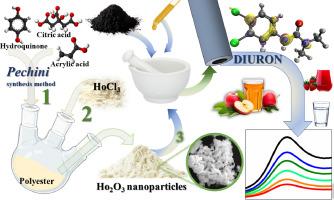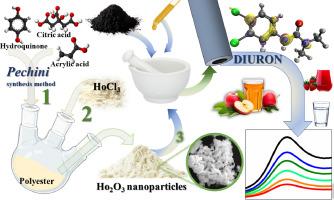Ho2O3纳米颗粒的Pechini合成方法及其在果汁样品中Diuron极灵敏电化学传感中的应用传感原理的理论见解
IF 5.6
3区 材料科学
Q1 ELECTROCHEMISTRY
引用次数: 0
摘要
本研究利用Ho2O3纳米颗粒升级后的碳糊电极(CPE),开发了一种用于检测diuron (DIU)的新型电化学传感器。采用Pechini法制备了Ho2O3纳米颗粒。利用x射线粉末衍射(XRPD)、衰减全反射(ATR) -傅里叶变换红外(FTIR)光谱和扫描电子显微镜(SEM)对材料的纳米结构进行了表征。采用循环伏安法(CV)和电化学阻抗谱法(EIS)研究了材料的电催化特性。建立了一种方波伏安法(SWV)识别和测定DIU的分析方法。该传感器对DIU具有显著的响应,线性范围宽(0.25 ~ 200µM),检测限为0.03µM。该方法受潜在干扰物质的影响最小,证实了该方法的选择性。CPE/Ho2O3传感器在检测水和果汁样品中的DIU时表现出良好的回收率。常规紫外-可见检测方法验证了传感器的有效性。本文章由计算机程序翻译,如有差异,请以英文原文为准。


Pechini synthesis method of Ho2O3 nanoparticles and their harnessing for extremely sensitive electrochemical sensing of diuron in juice samples; theoretical insights into sensing principle
This study developed a new electrochemical sensor for diuron (DIU) detection using a carbon paste electrode (CPE) upgraded with Ho2O3 nanoparticles. The Pechini method was used to synthesize Ho2O3 nanoparticles. The nanostructure properties of the material were confirmed using X-ray powder diffraction (XRPD), attenuated total reflectance (ATR) - Fourier transform infrared (FTIR) spectroscopy and scanning electron microscopy (SEM). The material electrocatalytic features were investigated using cyclic voltammetry (CV) and electrochemical impedance spectroscopy (EIS). An analytical method for identifying and measuring DIU was established using square wave voltammetry (SWV). The proposed sensor exhibited a remarkable response to DIU, displaying a broad linear range (0.25 - 200 µM) and a detection limit of 0.03 µM. Its minimal influence from potential interfering substances confirmed the method's selectivity. When detecting DIU in water and juice samples, the CPE/Ho2O3 sensor showed good recovery results. The conventional UV–Vis detection method validated the sensor efficacy.
求助全文
通过发布文献求助,成功后即可免费获取论文全文。
去求助
来源期刊

Electrochimica Acta
工程技术-电化学
CiteScore
11.30
自引率
6.10%
发文量
1634
审稿时长
41 days
期刊介绍:
Electrochimica Acta is an international journal. It is intended for the publication of both original work and reviews in the field of electrochemistry. Electrochemistry should be interpreted to mean any of the research fields covered by the Divisions of the International Society of Electrochemistry listed below, as well as emerging scientific domains covered by ISE New Topics Committee.
 求助内容:
求助内容: 应助结果提醒方式:
应助结果提醒方式:


